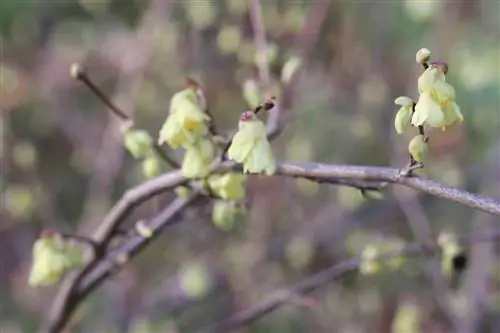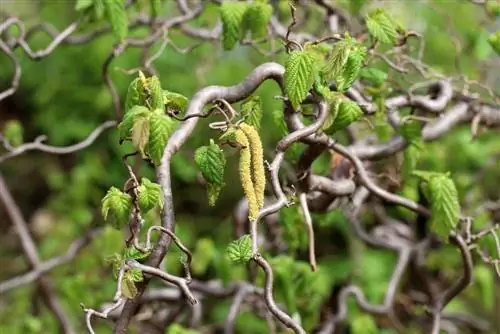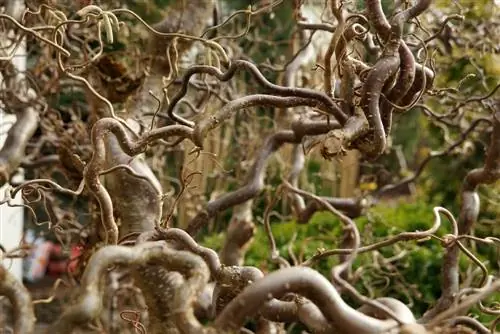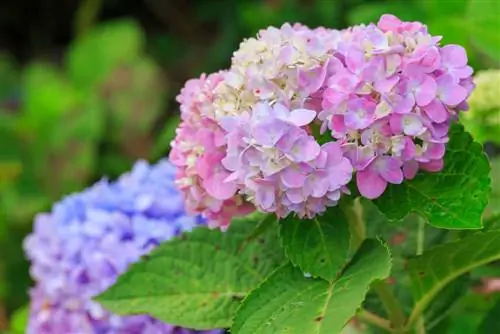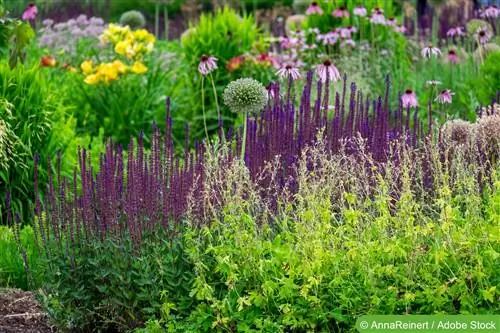- Author admin [email protected].
- Public 2023-12-17 03:39.
- Last modified 2025-06-01 06:48.
As the first early spring greeting, the spring sends us the false hazel with its flowers. When mild temperatures prevail in February, the shrub can show its first flowers. Since the hazel doesn't take up much space, you don't have to go without its flowers. The low false hazel was described by the botanist Philipp-Franz von Seibold and thus introduced into garden culture.
Introduction
The false hazel (Corylopsis pauciflora) comes from the forests of Japan and Taiwan. The botanical name comes from the Latin word “coryplus” - “hazel bush” and from the Greek word “opsis” - “appearance”. The word “pauciflora” comes from Latin and means “arm-blooded”, but it is still a shrub of the genus Corylopsis with abundant flowers. The light yellow flowers resemble drooping spikes. Depending on the type, they have a subtle scent that is reminiscent of primroses. The false hazel is often confused with the real hazelnut bush; the arrangement of the leaf veins is similar. The color of the hermaphrodite flowers is also similar to that of the male catkins of hazel. The false hazels belong to the witch hazel family. In fact, the flowers have a magical look.
Appearance
The false hazel opens its flowers early in the year. If you plant them on a protected wall of the house, you can enjoy the flowers even earlier. From March, sometimes as early as February, depending on the temperature, the false hazel shows its flowers, which look like small bells. However, the flowers are very susceptible to late frosts. Therefore it should be placed in small groups or in front of larger trees.
Profile
- Botanical name: Corylopsis pauciflora
- German name: false hazel, bell hazel
- Genus: Corylopsis pauciflora
- Growth height: up to 140 cm
- Winter hardiness: hardy
- Gender: hermaphrodite
- Frequency: monoecious
- Leaf arrangement: alternate
- Leaf structure: simple
- Flowering time: March/April
- Flowers: light yellow, 2-3 short spikes
- Use: popular ornamental plant
- 20 different types of hazel
Species
The following are the three best-known species:
- The false hazel (Corylopsis spicata) is also called bell hazel, eared hazel or high flower hazel. The bell hazel is also a flowering ornamental shrub in early spring. Its home is the mountain forests around Nagasaki and in Jang-Xi Province it can be seen as a small tree. The tree grows to a height of 2 to 3 meters and blooms at the beginning of April with forsythia and bloodcurrants. The flowers look like spikes and are 3-5 cm long and give off a pleasant scent. The ornamental shrub from the Far East has been cultivated here since 1865. The place in the garden for the false hazel should be chosen to be frost-proof. The early flowers can freeze in late frosts.
- The false hazel (Corylopsis pauciflora) is a dense and fine-branched shrub and can grow up to 1.5 meters high. The flowers are pale yellow and bell-shaped. Planting can be done in front of trees, in front of evergreen coniferous trees, in borders or in pots. Like Corylopsis spicata, it blooms leaflessly and early in the year. The false hazel creates an attractive eye-catcher in every garden. Since the shrub is relatively small, it likes to blend in with evergreen trees.
- Now we also have the Chinese hazel or Chinese flower hazel. It flowers lemon yellow and also comes from the witch hazel family. The Chinese hazel grows up to 5 meters high. It has bald or downy shoots. The inflorescences have racemes up to 4 cm long from which up to 18 flowers emerge. The natural distribution area is in central or western China. It grows in steppes and dry forests at altitudes of up to 1,500 meters. The Chinese hazel is also not frost hardy, it loves the warmth. It is often used as an ornamental shrub because of the wonderfully fragrant and decorative-looking flowers. A Corylopsis sinesis can also be planted in a small garden.
Care and cut
The false hazel is a grateful ornamental shrub that requires little care. The pretty and undemanding early bloomer still needs a few care tips so that it can bloom profusely the following year. A sunny to semi-shady location should be chosen. If the false hazel is in an exceptionally sunny location, it needs more water and needs to be watered more often. Some of the 20 known species of false hazel also love to stand in the shade, e.g. the low bell hazel. The soil should be rich in humus and not too dry and permeable to water.
Tip:
If you want lush flowers in spring, you can fertilize with compost in spring, which ensures abundant flower growth.
The hazel grows slowly, which means it doesn't need to be cut often. A cut should still be made if the false hazel grows too close to other plants. The best time is after flowering. Many hobby gardeners want to cut the hazel into shape. No damage is expected from the shrub. The false hazel can also cope with heavy pruning. If you have a Chinese hazel in your garden, you can no longer cut off such beautiful inflorescences. If you not only want to care for your hazelnut, but also multiply it, you can do so very easily. In summer, cut off a 20 cm long branch of the ornamental shrub and plant it in the ground. At the beginning you should water heavily until it has formed roots. If it grows, you will soon have a fragrant and bright yellow bush in your garden.
The false hazel can grow up to 1.5 meters high. The bell-shaped and delicate yellow flowers open early in the year. The flowers form numerous clusters 2 cm long. The red-brown leaf shoots only appear after flowering. The leaves turn yellow-orange in autumn. The Corylopsis pauciflora is the variety that blooms most profusely. Ideally suited as tenants under the false hazel, squill or star hyacinths, early bloomers, such as the false hazel itself.
Editor’s Tip
There are botanists who, just like with hazel bushes, rely on the stick, i.e. cut them back to just a few centimeters. It can then happen that the false hazel is broken after this cut or needs years to recover. The low false hazel (Corylopsis pauciflora) is particularly ideal for small gardens or front gardens. The shrub only grows to 1.50 m high and just as wide. The location should be chosen so that the early blooms are not lost due to frost.
Frequently asked questions
Can you grow mock hazel in a pot?
Yes, it should then be potted into a substrate every two years after flowering.
What should you consider when potting?
A light root cut is always good.
Should a drainage layer be laid?
Yes, definitely.
What you should know about the hazel bush in brief
- Mock hazels develop as deciduous shrubs or as smaller trees. They are among the first flowering plants of the year.
- If you find a sheltered spot for it, the hazelnut can bloom even earlier.
- The hazel is well suited for colorful garden design; the yellow flower works best when the background contrasts with it.
- The flower color is harmoniously supported by flower neighbors such as boxwood or winter scented viburnum.
- You can achieve attractive color contrasts by planting early bloomers, e.g. B. with scilla (squill) or star hyacinths (Chionodoxa).
- In any case, a false hazel with its compact, low growth can find a place in every garden where it enhances the beauty of the garden.
Care & Pruning
- All hazelnuts love humus-rich, deep soil that is not too dry and well drained.
- In any case, the false hazel benefits from a place in the garden that is fairly safe from late frosts.
- The false hazel bushes prefer to grow in light shade, but can otherwise tolerate any location in sun or shade.
- A false hazel bush doesn't actually need any care; you could only support its growth in spring with a little compost or fertilizer.
The false hazel is similarly easy to care for when it comes to pruning: Basically, a false hazel bush only needs to be pruned if you have given it a space that is too cramped. Otherwise, you can do without regular pruning, but you don't have to: If it becomes necessary for whatever reason, a false hazel can also tolerate a strong pruning. You can propagate your hazel bushes yourself, through cuttings or cuttings in summer.
Mock hazel - ecologically not the first choice
If you plan to include the false hazel in your garden planting, you should keep in mind that it is an exotic alien. Which is completely worthless for our wildlife because the fruits of the hazel bushes do not ripen in our climate, as do the fruits of rhododendrons and wig bushes.
If you value beneficial insects that stabilize the ecological balance and limit pest infestation, you should not only plant exotic ornamental shrubs, but also native trees that provide rich cover for wildlife all year round Offer a table. Your enjoyment of planting unusual trees in your garden doesn't necessarily have to suffer because there are numerous very interesting native plants that are hardly known anymore:
- For example, the German tamarisk, which is on our red list,
- but also shrubs that used to be so widespread, such as the blackthorn, which today has increasingly rare opportunities to provide a basis for life for the over 100 species of butterflies that are interested in it.

